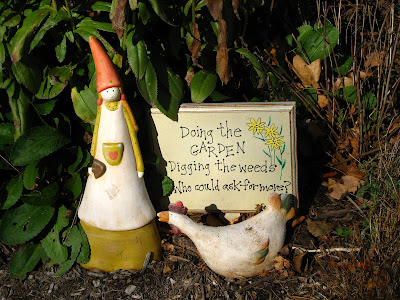
When we moved here, this was a very narrow, foundation-hugging strip of dirt, with a row of landscape blocks running its entire length. I gave the blocks to a neighbor and began digging the wider, curving bed I wanted.
That first settling-in year, I planted a few inexpensive shrubs and perennials to brighten this area until I could afford to “do it up right.” Mr. P.O. had bequeathed us only some daisies and yellow daylilies, and an overgrown barberry. Ninety percent of the bed was empty, unless you count bindweed and oxalis, which I still battle to this day.
On the east end, I planted three Weigela florida ‘Evita.’ These are a sight to see when dressed in their deep red flowers, but are a sprawling mess the rest of the season. I am still undecided about whether to keep them.

The purple stems and flower spikes of Salvia nemorosa ‘Caradonna’ provide a nice foil to Evita’s red. Other plants on this end include yarrow (Achillea ‘Moonshine’) and lamb’s ear (Stachys byzantina ‘Silver’Carpet’).

Near the center of the bed is a red rambling rose (Rosa ‘RADramblin’). She picks up where the weigela leave off with their show of red. My most vigorous rose, she reaches above the roofline every year, and puts on a non-stop show all summer. I’m thinking of trying a few cuttings from her next summer.

At the other end is a serviceberry (Amelanchier x grandiflora) I planted two years ago. At its feet is a variety of perennials, including Amsonia, Coreopsis, more Salvia, Nepeta, lilies, rock cress, and groundcover sedum.
In the middle section is a purpleleaf sand cherry (Prunus x cistena), and near her are several of my microclimate triumphs. My first clue to the potential zone-denying power of this bed came from two Caryopteris shrubs.

Here in zone 5 they are purported to die to the ground each winter, much like the butterfly bush. I went out in early spring to cut back the dead branches to make room for new growth. But lo and behold, the old stems had leaf buds all over them, and some were opening already. I let them be and they came in just fine—in fact, too fine.

By the end of the summer they were HUGE, and were smothering other plants around them. Yes, they were a gorgeous cloud of blue when they bloomed in the fall, but I really hadn’t planned for them to be so large. So the next winter, I went out nice and early, before they could bud, and cut them back. In the spring, I waited…and waited…and waited for new shoots. This time they didn’t return. Fortunately, they were rampant reseeders, so I’ve had plenty of babies to replace them.
This experience, though a mix of triumph and tragedy, encouraged me to try other marginal plants here. A neighbor had given me a Hydrangea macrophylla ‘Bluebird.’ It had never bloomed for her and she was tired of looking at it. I tried it in two shady, protected areas, with the same results. This is typical of the bigleaf hydrangeas in zone 5. They bloom on old wood, but die to the ground in winter, which means no flowers.
But then the lightbulb went off and I decided to give ‘Bluebird’ a cozy nest against the warm brick wall. (It is shaded by the sand cherry in summer.) Last spring I watched eagerly to see if it would produce any buds, but alas, the old wood was all dead. I cut it back and forgot about it. Then one day, what do you know! It suddenly had two floppy pink mopheads!

Whether it’s the location or some other factor, I am delighted that I have gotten this beauty to bloom. Never mind that I have a pink ‘Bluebird.’ (Mr. P.O. used to empty the fireplace ashes into this bed, so it’s highly alkaline, and of course hydrangeas need acidic soil to produce blue flowers.) It’s blooming and that’s enough for the moment.
I’ve had a couple of other successes too. Easter lilies are marginally hardy here, but last year one of mine had lovely trumpets. I’ve also had tri-color salvia return, though it’s sold as an annual here. On the other hand, I’ve replaced a ‘Golden Showers’ rose twice in this bed (I love its clear yellow blooms), despite good winter protection.
Clearly, microclimates are no guarantee of success. Still, I look forward to pushing the zone limits even more next summer.





.jpg)


.JPG)

.JPG)

.JPG)
.jpg)
+b_1_1.JPG)
_1_1.JPG)
_1_1.JPG)


.JPG)































